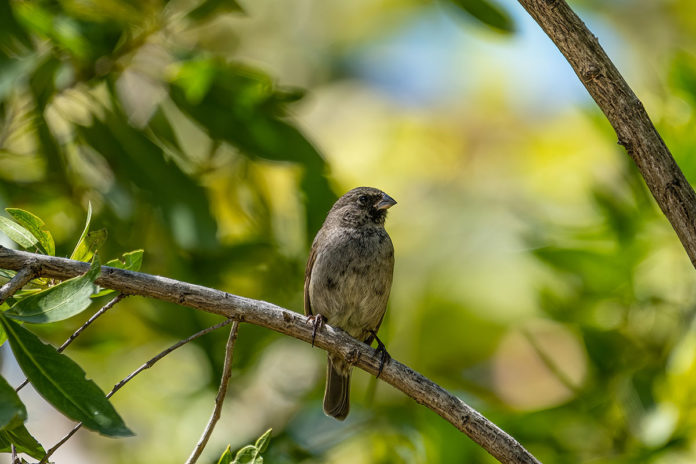I was hanging around with Kevin Christman, trying and failing to pick a splinter out of my index finger. Finally I gave in and put on my reading glasses so I could actually see the damn thing, and managed to bite it between my two incisors and pull it out. I’m not sure why I had to see something I was trying to grab with my teeth, but somehow it made the difference.
The splinter had come from the rough-hewn top rail of the fence around a section of native plants, which is currently thriving surrounded by the Casuarinas at Fort Zach. We were looking for the latest rare bird in the neighborhood, a black-faced grassquit.
We’d been working our way slowly around the fence, keeping our eyes down low, listening for the soft clear notes of the grassquit’s song. Occasionally we’d hear something, but it would turn out to be a warbler or nothing at all.
Christman is a tall dude, which the petty part of my brain thinks gives him an advantage in finding things. But in reality he’s just very keen-eyed and smart. He’s been here for four years, but already knows more about Keys’ flora and fauna, and especially its birds, than most people will know in their entire lifetime.
Kevin had posted something on Facebook about seeing the grassquit, and I texted him to ask if it was still there. He said he’d heard it, and had brief looks at it, but offered to stick around to try for a better look if I was heading over. That’s how we ended up leaning on a splinter-ridden fence like a couple of farmers.
Black-faced grassquits are a Caribbean species, with eight subspecies spread out over dozens and dozens of islands. A lot of the rarities that show up in the Keys are most likely from Cuba, but oddly enough, the black-faced grassquit is not found on the island, only in limited numbers on a couple of small islands off the big island’s north coast.
The American Birding Association actually has a ranking for bird species and how common they are. A Code-1 bird is a widespread, everyday bird. Think northern mockingbird or laughing gull. A Code-6 bird is extinct.
The black-faced grassquit is actually a Code-4 bird – rarer than rare, though not the rarest.
The first black-faced grassquit seen in North America showed up in Miami in 1871. It took 89 years for the next one to be spotted, though they have since become more common, with about two dozen records in total.
“Quit” is apparently an old Jamaican term for a small bird. Grassquits are known for their love of grasslands and other types of low-to-the-ground habitats. While originally thought to be a member of the finch family, recent DNA analysis shows they are most closely related to Darwin’s finches, which, just to keep things confusing, are actually 18 species of tanagers. The National Audubon Society’s website describes the black-faced grassquit as a “stubby little finch,” which, besides being out of date, is also kind of ungenerous.
One of the first birds I ever chased was a black-faced grassquit that showed up at Long Pine Key Campground in Everglades National Park in 2003. I’d had insomnia the night before, but got up before dawn and drove up with a friend to stare for five hours into the endless fronds of saw palmettos and not see it. That may have contributed to my reluctance to chase rarities. (I did see a flock of common nighthawks slow-flap through the slash pines that day, though. It’s an image that has stuck with me, so maybe it was kind of worth it.)
Before the Fort Zach bird, the most recent black-faced grassquit was one that hung out at the Blue Hole on Big Pine from July 2019 to May 2021. That one was my lifer. But it stayed so long that people took it for granted. Until it moved on.
Mark Songer had found the grassquit we were looking for at Fort Zach in mid-November, but it had disappeared right after he saw it. I thought this was the first re-sighting, but looking at the data on eBird, it had been seen regularly since Jan. 15. I just wasn’t paying attention.
Fort Zach was crowded with the bathing suit-clad. I didn’t think Kevin and I particularly stood out – I wasn’t even wearing my zipper-legged adventure pants – but I guess our cameras and fancy binoculars caught people’s attention, because folks kept stopping to ask us what we were looking at. We kept having to say, nothing really, then tell them what we were trying to look at.
I was considering heading home when this guy Rich, who can be found a lot of days at one of the picnic tables closer to the parking lot, usually surrounded by birds, came up behind us.
“You looking for the grassquit?” he asked. We followed him to a Jamaica caper about 20 yards away. “It’s in there,” he said.
It took about three minutes for him to be proven right. The grassquit flitted around less than a foot off the ground at first. Then it leapt up slightly higher and slightly more out in the open.
Female black-faced grassquits and juvenile black-faced grassquits look pretty much alike. But this one’s face looked like it was starting to go dark, meaning it was probably a young male just maturing. We watched it for about five minutes before he receded deeper into the foliage.
You never know how long a rarity is going to stay around. But I hope that guy continues to thrive.






















